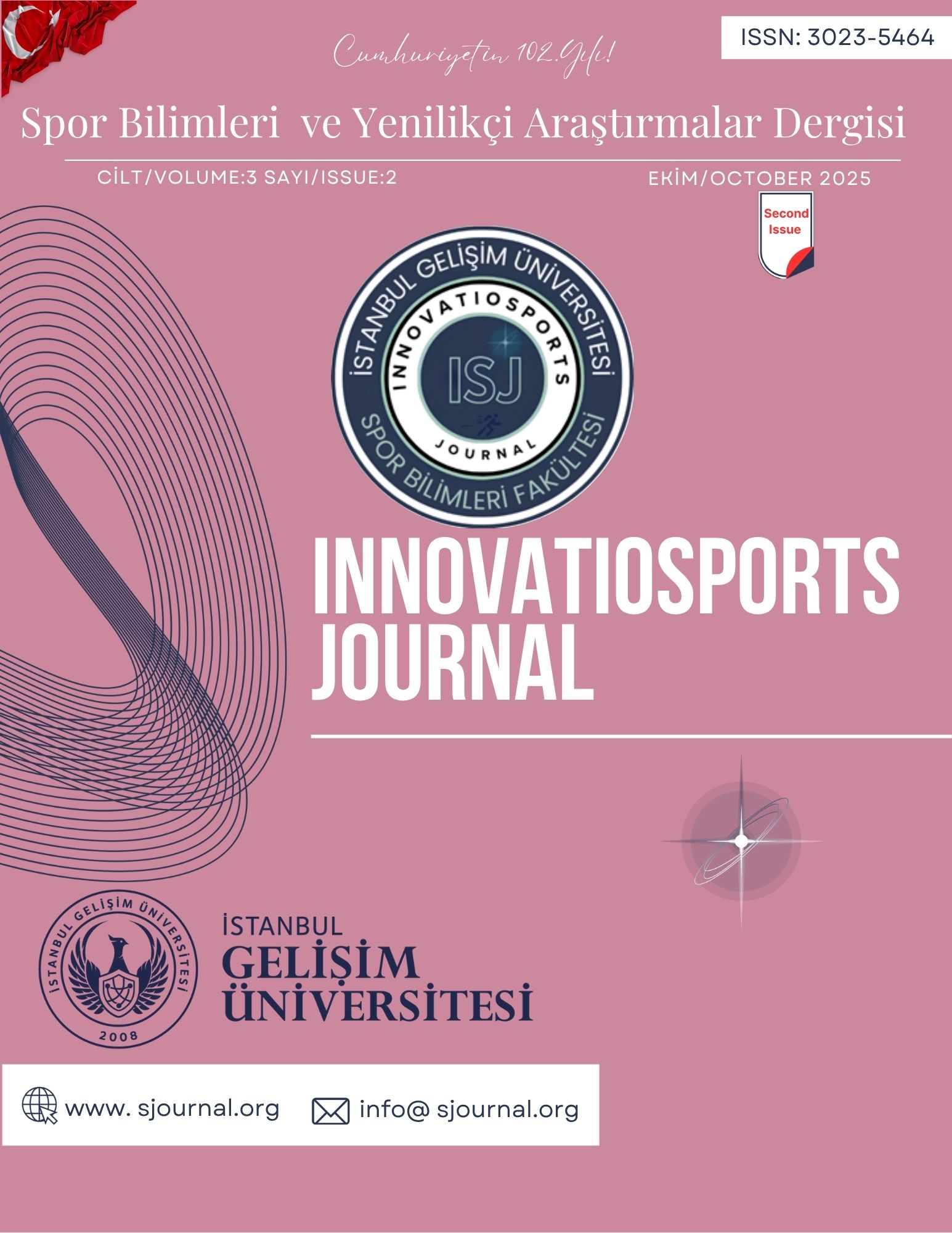Determination of Exercise and Nutrition Behaviors of Middle School Students
DOI:
https://doi.org/10.5281/zenodo.17504215Keywords:
Middle school students, exercise, nutrition behaviors, nutrition education, healthy lifestyleAbstract
The aim of this study was to examine the exercise and nutrition behaviors of middle school students and to determine whether these behaviors differ according to gender, socioeconomic status, regular exercise habits, and participation in nutrition education. The research was conducted using a survey model, one of the quantitative research methods. The population of the study consisted of middle school students studying in the city center of Bitlis. A total of 307 students who met the inclusion criteria and voluntarily agreed to participate were included in the study. Data were collected through a Demographic Information Form prepared by the researchers and the Nutrition-Exercise Behavior Scale developed by Yurt et al. (2016). Descriptive statistics, independent samples t-test, and one-way analysis of variance (ANOVA) were used for data analysis. Findings revealed that approximately two-thirds of the participants engaged in regular exercise, although the frequency was generally limited to 1–2 days per week. Students who exercised regularly scored significantly higher on the healthy nutrition-exercise behavior subscale (p<0.05). In addition, students who received nutrition education had significantly higher scores compared to those who did not. Regarding socioeconomic status, students from middle-income families obtained higher scores in meal regularity, whereas no significant differences were observed in terms of gender or anthropometric characteristics. The study concluded that middle school students’ exercise and nutrition behaviors were at a moderate level overall. However, students who exercised regularly and received nutrition education demonstrated more favorable behaviors. These findings highlight the importance of designing school-based programs that integrate both physical activity promotion and nutrition education.
References
Akman, M., Akan, H., İzbirak, G., Tanrıöver, Ö., Tilev, S. M., Yıldız, A., … & Hayran, O. (2010). Eating patterns of Turkish adolescents: A cross-sectional survey. Nutrition Journal, 9, 67. https://doi.org/10.1186/1475-2891-9-67
Akman, M., Tüzün, S., & Ünalan, P. C. (2012). Adölesanlarda sağlıklı beslenme ve fiziksel aktivite durumu. Nobel Medicus Journal, 8(1), 35–40.
Büyüköztürk, Ş., Kılıç Çakmak, E., Akgün, Ö. E., Karadeniz, Ş., & Demirel, F. (2008). Bilimsel araştırma yöntemleri. Ankara: Pegem Akademi.
Ceviz, E., & Genç, H. (2021). Çocuklarda obezite ve fiziksel aktivite. In İ. Kayantaş & M. Ilkım (Eds.), Spor bilimlerinde araştırma ve değerlendirmeler – I (pp. 175–202). Gece Kitaplığı.
Farsi, D. J. (2024). Diet quality and physical activity and their association with BMI and dental caries among high school adolescents: A cross-sectional study. Children, 11(11), 1282. https://doi.org/10.3390/children11111282
Gao, Z., Chen, S., Sun, H., Wen, X., & Xiang, P. (2016). Physical activity, fitness, and health in school-aged children. Journal of Sport and Health Science, 5(1), 1–2. https://doi.org/10.1016/j.jshs.2016.01.003
Guthold, R., Stevens, G. A., Riley, L. M., & Bull, F. C. (2020). Global trends in insufficient physical activity among adolescents: A pooled analysis of 298 population-based surveys with 1.6 million participants. The Lancet Child & Adolescent Health, 4(1), 23–35. https://doi.org/10.1016/S2352-4642(19)30323-2
Gümüş, A. B., Bulduk, S., & Arslan, P. (2019). Erken ve orta adölesan dönemdeki bireylerin ana öğün atlama ve fast-food tüketim eğilimleri. Balıkesir Sağlık Bilimleri Dergisi, 8(3), 135–142. https://doi.org/10.46971/ausbid.701023
Janssen, I., & LeBlanc, A. G. (2010). Systematic review of the health benefits of physical activity and fitness in school-aged children and youth. International Journal of Behavioral Nutrition and Physical Activity, 7(1), 40. https://doi.org/10.1186/1479-5868-7-40
Karasar, N. (2009). Bilimsel araştırma yöntemi: Kavramlar, ilkeler, teknikler (19. baskı). Ankara: Nobel Yayın Dağıtım.
Keleş, Ö. F., & Alpkaya, U. (2016). Ortaokul öğrencilerinin düzenli sportif aktivite ve okul başarı puanlarının karşılaştırılması. Marmara Üniversitesi Spor Bilimleri Dergisi, 1(2), 31–36. https://doi.org/10.22396/sbd.2017.13
Keskin, K., Çubuk, A., Öztürk, Y., & Alpkaya, U. (2017). 12–14 yaş çocukların fiziksel aktivite düzeyleri ile beslenme davranışları arasındaki ilişkinin incelenmesi. İstanbul Üniversitesi Spor Bilimleri Dergisi, 7(3), 34–43.
Kutlu, R., & Çivi, S. (2009). Özel bir ilköğretim okulu öğrencilerinde beslenme alışkanlıklarının ve beden kitle indekslerinin değerlendirilmesi. Fırat Tıp Dergisi, 14(1), 18–24.
LeBlanc, J., et al. (2022). The association between adolescents’ food literacy and their consumption of vegetables and fruits and other eating behaviors. Health Education & Behavior, 49(4), 603–612. https://doi.org/10.1177/10901981221086943
McEachern, L. W., Ismail, M. R., Seabrook, J. A., & Gilliland, J. A. (2022). Fruit and vegetable intake is associated with food knowledge among children aged 9–14 years in Southwestern Ontario, Canada. Children, 9(10), 1456. https://doi.org/10.3390/children9101456
Okut, S., & Kahraman, M. Z. (2025). The role of body composition in determining athletic performance in adolescent female cross-country skiers. Advances in Health and Exercise, 5(1), 32–39.
Önal, S., & Uçar, A. (2024). Okul çağı çocuklarının eğitim gördükleri okullara göre kahvaltı yapma ve beslenme durumlarının değerlendirilmesi. Beslenme ve Diyet Dergisi (Journal of Nutrition and Dietetics), 52(2), 48–58. https://doi.org/10.33076/2024.BDD.1850
Öztürk, M. (2019). Çocuk ve ergenlerde fiziksel aktivite düzeylerinin incelenmesi. Spor Bilimleri Dergisi, 30(2), 89–98.
Downloads
Published
How to Cite
Issue
Section
License
Copyright (c) 2025 InnovatioSports Journal

This work is licensed under a Creative Commons Attribution 4.0 International License.


